La differece of being woman
Research and Teaching of History
Area: Essays
Life and Non-life: Plagues and Slaughter María-Milagros Rivera Garretas.
María-Milagros Rivera Garretas.
Introduction
The population of Europe has suffered from plague epidemics since its origin until the discovery of synthetic antibiotics in the middle of the twentieth century. In the towns the suffering was worse, because of the quicker rate of contagion due to the unhealthiness of the water and the air, and the human concentration in them. To protect themselves, those who could fled to high and healthy places in the country. The most deadly epidemic was the Black Death of 1348. It was called thus because the disease produced black patches on the skin, called carbuncles, which are subcutaneous blood haemorrhages that could be very big; also lumps called bubos or curses, from where the name of bubonic plague, which it is also called, derives.
A literary memory of the Black Death has been conserved in the first book of the Decamerón de Giovanni Bocaccio: Boccaccio tells us in it that this book –which, in reality, is a very intelligent and complicated political allegory- is made up of the stories that were invented over ten days to entertain themselves by a group of young girls and boys who had fled Florence when the Black Death had reached that city while waiting for the epidemic to pass.
The plague epidemics were transmitted by rats that travelled on commercial boats, by the cloths, by ill people… Death was quick. But not all the people who were exposed to it died: some were cured and, what is more, there were women and men who were immune to this disease.
On passing, the plague left behind it towns and villages that were sometimes decimated, devastated families, children without a mother, abandoned working fields, more difficult production systems... In the second half of the fourteenth century the plague epidemics were especially frequent in Europe. As a consequence of it, the sense of time of one’s own life changed and the relationship with death.
The account of the Memorias of Leonor López de Córdoba
Present-day historiography has studied, sometimes with great erudition and accuracy, the social and economic transformations that the plague epidemics in Europe brought about, especially in the fourteenth, fifteenth and sixteenth centuries. There have been analyses of the changes in the structure of the population, the ploughing, livestock, relations of production, in social battles, in the incomes of the nobility, in the oscillations of prices and salaries, in medical knowledge, in the relationship with one’s own body and with other bodies... that is, in the historical experience that fits inside the paradigm of the social.
The extraordinary historical source that is the account of the Memorias of Leonor López de Córdoba –a woman who directly lived through at least two of these epidemics, suffering them without being infected– hardly gives, however, data of a social and economic character. It gives, on the other hand, much and very good data and assessments of another order of things and relationships. Another order of things and relationships that some of us women have called practices of creation and re-creation of life and human living together. An order of things and relationships that, with the words to say it, configures the symbolic order of the mother.
The practices of creation and re-creation of life and human living-together consist of the maternal work (bodies and relationships: human bodies, that is, that have learned from the mother language, that is, the symbolic, the coincidence between words and things) and in all the activities linked to: a) the culture of birth; b) the care of the non-autonomous human beings of the group; c) the processing and distribution of foods; d) the socialisation of the children; e) the practices and habits of hygiene; f) rest and shelter; g) the technical aspects related to all these tasks. The divine dimension of these practices was perceived brilliantly by Simone Weil in a text of 1943 entitled Las necesidades del alma (Simone Weil, Echar raíces, trans. by Juan Carlos González Pont and Juan Ramón Capella, Madrid, Trotta, 1996, 23-50).
Recognising and naming the practices of creation and re-creation of life and human living-together in the world of today and in history brings to the light a great area of the real: the primary work of civilisation, a work that is historically more feminine than masculine.
La diferencia de ser mujer
Amongst the data and historical assessment that Leonor López de Córdoba gives in the fragments cited from her Memorias, I single out two. Firstly, the importance that the practice of relationship or relational context in which her life moved had for her: the relationships with her sons and her daughter, with her aunt, with her women cousins, with the Jewish boy –baptised Alonso- that she had adopted as a child when the Jewish quarter was brutally attacked by the Christians in 1392, with the old followers of her father the master of Calatrava y Alcántara Martín López de Córdoba... These relationships do not receive their meaning from the wealth or money but rather from what they might give to life and living-together: that is why we call them relationships of authority, which is different to power.
Secondly, I single out her daring in deciding on life or non-life. I am referring to the process which took her son Juan to death, who, as Leonor writes, “was very sickly”. Faced with the need to watch over the converted Jew Alonso –who is the one who has brought the plague to Aguilar but should not lose the link with the alive because this link might frighten off death-, Leonor, author of life, administers the life of those who depend on her with alarming freedom: freedom that we call, with other women feminine freedom, because it is relational freedom. The capacity to be two that a woman is born with implies that she has to take fundamental decisions on life and non-life: for example, when she freely has an abortion or excludes pregnancy and maternity from her experience. I say life and non-life, and not life and death, because I am talking about something very different to what more men than women have done historically in wars and homicides. I am talking about the decision to give birth or not, to attend to or not the continuation of a life, which is a fundamental and terrible decision that, historically, has been and is, more a decision of women than of men. A decision that is situated in a place that is beyond the law, not against the law.
On relating what happens to her in her Memorias, Leonor López de Córdoba made symbolic. This means that she put freely into words what was happening to her, capturing and blending with care, love of truth and fidelity to herself the sense of the events that she lived through.
None of this is spoken about in a present-day book of history on the epidemics of plague, not even the books that follow a paradigm of the social and its aspiration to write total history. They do not do it, not because social historians might forget that in history there are women and little girls, nor because they are necessarily misogynist – as we feminists used to say in the seventies and eighties of the twentieth century -, but because the paradigm of the social is too small to contain feminine human experience.
Teaching suggestions
It is useful to compare and contrast in class the proposed text of Leonor López de Córdoba with the beginning of the First act of the Decamerón by Giovanni Boccaccio . Boccaccio writes an objective description of the facts and a critique of the professionalisation of medicine in the fourteenth century, a professionalising that involved in its progressive masculinisation the endowment of instances of power and monetary significance; his voice is, therefore, a good example of social history. The text of Leonor is an example of history in the first person, setting out from the self, a history in which the most significant thing is the relational context that she and those who surround her live in; her voice is, therefore, in the symbolic order of the mother.
“And I say, then, that the years since the fructiferous incarnation of the son of God had reached one thousand three hundred and forty eight, when in the distinguished city of Florence, most beautiful of all those of Italy, a deathly plague struck. Which, whether by the work of the heavenly bodies, or by our wicked acts, was in virtue of the just anger of God, sent to mortals to correct us, after having begun some years before in the oriental regions, where it snatched away an uncountable amount of lives and from where, without stopping in any place, it continued, devastating, towards the West, continuously extending itself. And neither precaution nor any human providence was any use against it, such as special workers carrying out the cleaning the city, prohibiting any sick person from entering the city, and giving out much advice on looking after health, and making, not once, but many times, humble pleas to God, in ordered processions, and in other ways, by devoted people. In any case, the fact was that, at the beginning of spring of the previous year, the painful effects of the pestilence began to manifest themselves, horribly and miraculously. But it did not go as it did in the East, where the pouring of blood from the nose was a sure sign of inevitable death, but rather here, when the disease began, to women and men there came, in the groin or in the armpits, swellings that at times reached the size of a common apple, and others like an egg, and others smaller and others bigger. The ordinary people gave these lumps the name of bubos. And, in a short time, the deathly inflammations began to appear indistinctly on all parts of the body; and straightaway the symptoms of the disease changed into black or livid marks that came out on many on arms, thighs and other parts of the body, some big and spread out, others squashed and small. And just as the primitive bubo was, and continued to be, a certain sign of future death, so too were these marks. To cure this disease neither doctors’ advice nor the merits of any medicine appeared to be of any use, whether because the nature of the illness did not permit it, or whether, because of the ignorance of medicines (which, apart from that of the men of science, had become very great among men and women lacking in all knowledge of medicine) the origin of the harm and the way of stopping it had become lost to them. And thus, not only were there few who were cured, but also that almost all, on the third day of the appearance of the aforementioned signs, either sometime before or sometime after, died without any fever or any other accident.” (Giovanni Boccaccio, El Decamerón, trans. Juan G. de Luaces, Barcelona, Plaza y Janés, 1980, 4th Ed., 13-14).
Images
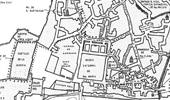
Map of the neighborhood or grouping of Santa María or of la Mezquita, of the city of Cordoba, at the...
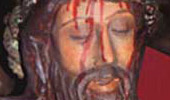
Crucified Christ (fourteenth century). Royal Convent of Santa Clara (Astudillo, Palencia).

Map of the Royal convent church of San Pablo de Córdoba.

Tomb of Leonor López de Córdoba (1362/63-1430). Royal convent church of San Pablo de Córdoba. Photo:...

Facade of the chapel of the Trinity (also called Saint Thomas Aquinas, today of the Rosario), of the...
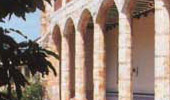
Courtyard of the Royal Convent of Santa Clara (Astudillo, Palencia), founded by María de Padilla. Fo...
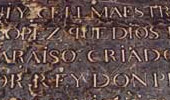
Tomb of Martín López de Córdoba. Chapel of the Trinity, royal convent church of San Pablo de Córdoba...

Coat of arms of the Hinestrosa family
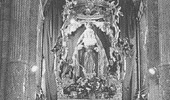
Chapel of the Trinity, today of Nuestra Señora del Rosario. Royal convent church of San Pablo de Cór...

Courtyard of the Royal Convent of Santa Clara (Astudillo, Palencia), founded by María de Padilla. Fo...

Mudejar palace of Pedro I and María de Padilla. Astudillo (Palencia). Fourteenth century.
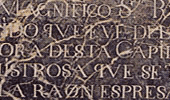
Tomb of Ruy Gutiérrez de Hinestrosa and Gutierre de Hinestrosa. Royal convent church of San Pablo de...
© 2004-2008 Duoda, Women Research Center. University of Barcelona. All rights reserved. Credits. Legal note.
Credits
Scentific Direction: Maria Milagros Rivera Garretas
We are thankful to the Research Project from the Instituto de la Mujer I + D entitled: "Entre la historia social y la historia humana: un recurso informático para redefinir la investigación y la docencia" (I+D+I 73/01) for its financial support to this project.
Institut Català de la Dona de la Generalitat de Catalunya and the Agrupació de Recerca en Humanitats de la Universitat de Barcelona for they contribution to its development (22655).
Technical Direction: Dr. Óscar Adán
Executive Production: Dr. Sonia Prieto
Edition: Marta García
Correction: Gemma Gabarrò
Catalan Translation: David Madueño
English Translation: Caroline Wilson
German Translation: Doris Leibetseder
Italian Translation: Clara Jourdan
Legal note
Copying or reproduction in whole or in part by whatever means is prohibited without express written authorization.
The texts, data and information contained in these pages are free for personal use. However, written permission from Duoda, Women Research Center is required for their publication in any medium or for their use, distribution or inclusion in other contexts accessible to third parties.
© 2004-2008 Duoda, Women Research Center. University of Barcelona. All rights reserved.
